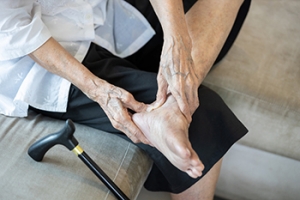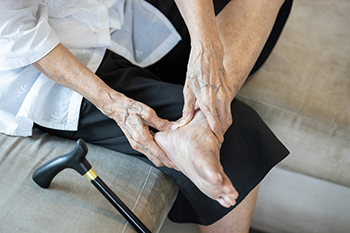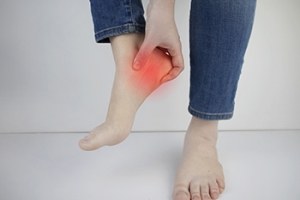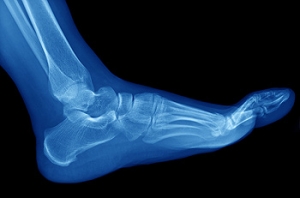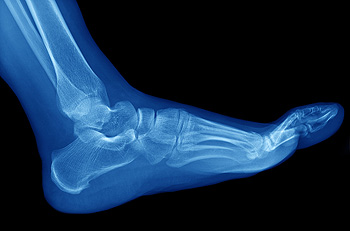Super User
When to Consider Ankle Replacement Surgery
In some cases of osteoarthritis of the ankle, the damage caused by the deterioration of the bones rubbing against each other may lead to some form of surgery. This is not a decision to be taken lightly, because it can permanently affect your lifestyle and the movement of your ankle joint. Osteoarthritis is degenerative, where the cartilage between the talus bone in the heel and the tibia in the leg erodes. As a result the bones press on each other and wear away. Three main types of ankle surgery are joint replacement, fusion and triple fusion. Joint replacement surgery removes the damaged ends of the bones and replaces them with metal or plastic ends, which can last for up to 15 years. Triple fusion surgery involves using screws, staples or plates to fuse three bones. It may take up to 3 months for the fusion to be complete. Ankle fusion connects the end of the talus bone in the heel to the end of the tibia in the leg. The ankle loses all mobility, but remains pain-free. If you have ongoing ankle pain that has become severe enough to affect your daily life, it is suggested that you discuss your options with a podiatrist at your earliest convenience.
Ankle pain can have many different causes and the pain may potentially be serious. If you have ankle pain, consult with one of our podiatrists from Westside Podiatry Center, LLP. Our doctors will assess your condition and provide you with quality foot and ankle treatment.
Ankle pain is any condition that causes pain in the ankle. Due to the fact that the ankle consists of tendons, muscles, bones, and ligaments, ankle pain can come from a number of different conditions.
Causes
The most common causes of ankle pain include:
- Types of arthritis (rheumatoid, osteoarthritis, and gout)
- Ankle sprains
- Broken ankles
- Achilles tendinitis
- Achilles tendon rupture
- Stress fractures
- Tarsal tunnel syndrome
- Plantar fasciitis
Symptoms
Symptoms of ankle injury vary based upon the condition. Pain may include general pain and discomfort, swelling, aching, redness, bruising, burning or stabbing sensations, and/or loss of sensation.
Diagnosis
Due to the wide variety of potential causes of ankle pain, podiatrists will utilize a number of different methods to properly diagnose ankle pain. This can include asking for personal and family medical histories and of any recent injuries. Further diagnosis may include sensation tests, a physical examination, and potentially x-rays or other imaging tests.
Treatment
Just as the range of causes varies widely, so do treatments. Some more common treatments are rest, ice packs, keeping pressure off the foot, orthotics and braces, medication for inflammation and pain, and surgery.
If you have any questions, please feel free to contact one of our offices located in Liverpool, Camillus, Skaneateles, Oswego, and Cicero, NY . We offer the newest diagnostic and treatment technologies for all your foot care needs.
Ankle Pain
Pain experienced in the ankle can be caused by a multitude of conditions. While the most common cause is an ankle sprain, other possible problems can include arthritis, gout, ankle instability, an ankle fracture, nerve compression, or tendinitis. In more serious cases, ankle pain can be a sign of improper alignment of the foot or an infection.
Ankle pain can often be accompanied by symptoms such as redness, swelling, stiffness, and warmth in the affected area. Pain can be described differently depending on the condition: short, stabbing pain and a dull ache are some examples. If such symptoms are persistent and do not improve after time, be sure to schedule an appointment with your local podiatrist.
Depending on the condition causing your ankle pain, different treatments may be prescribed by your podiatrist. For ankle sprains, the first step in treatment involves rest, ice, elevation, and compression. Be sure to avoid placing pressure on the ankle, use an ice pack several times a day, and use a compression bandage and elevation to reduce swelling. Other, more serious conditions may require the assistance of certain drugs and medications such as nonsteroidal anti-inflammatory drugs (NSAIDs), physical therapy, or even cortisone injections.
Depending on the severity of your ankle pain and the condition behind it, recovery from ankle pain may take some time.
Consult with your foot and ankle doctor to best determine the cause of your ankle pain and the appropriate treatment.
Four Ways Diabetics Can Take Care of Their Feet
Diabetes can reduce blood flow and decrease your body’s ability to heal. Both complications can lead to, and exacerbate, foot problems, which makes it vitally important for diabetics to take care of their feet. The following four measures are basic, yet very effective as part of a daily diabetic foot care regimen. 1) Perform a thorough daily inspection of your feet to check for any injuries that may have developed such as cuts, scrapes, blisters, bruises, swelling, changes in skin color, and more. If you notice anything unusual, make an appointment with your podiatrist right away. 2) Take care of the skin on your feet to avoid any infections or cracked skin. Wash and dry your feet every day and keep them moisturized—taking care to keep the area between your toes dry and free from lotion. 3) Your feet should always be covered when you are walking to keep them protected from injury. Wear slippers around the house, and your socks should never be tight. 4) Keep the blood flowing in your feet by elevating them whenever possible and wiggling them for a few minutes throughout the day. If you have diabetes, see your podiatrist for regular checkups. They can ensure that your feet are staying healthy and offer you professional foot care advice.
Diabetic foot care is important in preventing foot ailments such as ulcers. If you are suffering from diabetes or have any other concerns about your feet, contact one of our podiatrists from Westside Podiatry Center, LLP. Our doctors can provide the care you need to keep you pain-free and on your feet.
Diabetic Foot Care
Diabetes affects millions of people every year. The condition can damage blood vessels in many parts of the body, especially the feet. Because of this, taking care of your feet is essential if you have diabetes, and having a podiatrist help monitor your foot health is highly recommended.
The Importance of Caring for Your Feet
- Routinely inspect your feet for bruises or sores.
- Wear socks that fit your feet comfortably.
- Wear comfortable shoes that provide adequate support.
Patients with diabetes should have their doctor monitor their blood levels, as blood sugar levels play such a huge role in diabetic care. Monitoring these levels on a regular basis is highly advised.
It is always best to inform your healthcare professional of any concerns you may have regarding your feet, especially for diabetic patients. Early treatment and routine foot examinations are keys to maintaining proper health, especially because severe complications can arise if proper treatment is not applied.
If you have any questions please feel free to contact one of our offices located in Liverpool, Camillus, Skaneateles, Oswego, and Cicero, NY . We offer the newest diagnostic and treatment technologies for all your foot and ankle needs.
How to Care for Diabetic Foot
Millions of people are affected by diabetes each year. Diabetes damages blood vessels in all parts of the body, especially the feet. The legs and feet may develop slow blood flow, which causes neuropathy, or nerve damage. Once a diabetic patient develops neuropathy, it is important that the feet are well taken care of. Otherwise, the lower limbs may have to be amputated. This only happens in drastic cases, but it shows how seriously diabetic foot care should be taken.
It is very important to always wash and dry the feet thoroughly, especially in between the toes, if you’re a diabetic. Secondly, examining your feet and toes for redness or sores must be done, even if you do not feel pain. You may also want to examine your feet from the bottom. Try to avoid wearing colored socks to prevent infections that may occur from the dye. Well-fitting socks are also highly recommended.
A diabetic’s physician should always monitor their blood levels to test how well blood sugars are being maintained. In addition to giving advice about everyday eating habits and foot care, a physician may prescribe medicine to help with the diabetic patient’s neuropathy. It is also advised to see a podiatrist if experiencing any feet conditions. Toenails may also need to be taken care of by a podiatrist. This prevents patients from cutting too deeply around their cuticles, which can lead to infection.
A person can take care of their feet at home by following the instructions of their physician. Using creams on one’s feet is also an effective way to heal dryness. Proceed with caution when using tools to remove calluses, as severe diabetics may not be able to feel pain on their feet. If any complications arise do not hesitate to contact a podiatrist.
On a daily basis, diabetic feet must be checked. If you are ever concerned about something, contact your health care professional. You never want to wait until a wound becomes too severe to treat. If left untreated, gangrene may develop. Gangrene is a serious infection that can lead to sepsis or amputation. It is also important for diabetics to be on the lookout for ulcers. Ulcers are sores that develop from tissue loss on the skin. They can be quite painful and require intensive treatment. Early treatment and everyday inspection are imperative to staying healthy.
Why Do My Feet Hurt During Pregnancy?
 Experiencing leg and foot pain during pregnancy is a common ailment most women suffer from, especially during the second and third trimester. Swollen feet, also referred to as edema, is often caused by excess blood and fluids accumulating in the tissues. Additionally, an increase in estrogen and other hormones may cause flat feet, causing the heels and arches to become sore. The excess weight acquired during pregnancy is also a factor, causing the ankles and feet to increase in size, possibly causing pain while walking. One preventative measure that may help a flat-footed condition is purchasing shoes with adequate arch support. Drinking plenty of water could help to flush out excess sodium, thereby reduce swelling in the feet.
Experiencing leg and foot pain during pregnancy is a common ailment most women suffer from, especially during the second and third trimester. Swollen feet, also referred to as edema, is often caused by excess blood and fluids accumulating in the tissues. Additionally, an increase in estrogen and other hormones may cause flat feet, causing the heels and arches to become sore. The excess weight acquired during pregnancy is also a factor, causing the ankles and feet to increase in size, possibly causing pain while walking. One preventative measure that may help a flat-footed condition is purchasing shoes with adequate arch support. Drinking plenty of water could help to flush out excess sodium, thereby reduce swelling in the feet.
Pregnant women with swollen feet can be treated with a variety of different methods that are readily available. For more information about other cures for swollen feet during pregnancy, consult with one of our podiatrists from Westside Podiatry Center, LLP. Our doctors will attend to all of your foot and ankle needs.
What Foot Problems Can Arise During Pregnancy?
One problem that can occur is overpronation, which occurs when the arch of the foot flattens and tends to roll inward. This can cause pain and discomfort in your heels while you’re walking or even just standing up, trying to support your baby.
Another problem is edema, or swelling in the extremities. This often affects the feet during pregnancy but tends to occur in the later stages.
How Can I Keep My Feet Healthy During Pregnancy?
- Wearing orthotics can provide extra support for the feet and help distribute weight evenly
- Minimize the amount of time spent walking barefoot
- Wear shoes with good arch support
- Wear shoes that allow for good circulation to the feet
- Elevate feet if you experience swelling
- Massage your feet
- Get regular, light exercise, such as walking, to promote blood circulation to the feet
If you have any questions please feel free to contact one of our offices located in Liverpool, Camillus, Skaneateles, Oswego, and Cicero, NY . We offer the newest diagnostic and treatment technologies for all your foot and ankle needs.
Pregnancy and Foot Health
Many pregnant women complain about foot pain while they are expecting. Foot pain can primarily be caused by weight gain and hormonal changes taking place in the body. By understanding how pregnancy impacts the health of a woman's feet, a pregnant woman can take action to keep her feet as healthy and comfortable as possible.
Because a woman's weight changes during pregnancy, more pressure is brought to bear on both the legs and the feet. This weight shift can cause two major foot problems: over-pronation, also known as flat feet, as well as edema, which is swelling of the feet. Over-pronation occurs when the arch of the foot flattens, causing the foot to roll inwards when the individual is walking, and can aggravate the plantar fascia tissues located along the bottom of the feet. If these tissues become inflamed, a pregnant woman can experience pain in the heel of the foot as well as severe foot pain while walking or standing. Swelling of the feet, or edema, often occurs in the later stages of pregnancy. It is caused by slow circulation and water retention, and may turn the feet a light purple color.
To keep feet in good health and prevent over-pronation, pregnant women should avoid walking barefoot and be sure they are wearing shoes that offer good arch support. A device known as an orthotic can be added to regular footwear in order to provide additional support for the feet during pregnancy. Any expectant mother whose feet hurt should first check to see if the shoes she is wearing are old, worn out and not offering the proper support necessary for distributing the weight of her body during pregnancy.
To treat edema of the feet, a good start is to wear quality footwear which offers support and good circulation. Keep feet elevated whenever possible by using a foot stool while seated. Stay well hydrated by drinking plenty of water to prevent water retention in the feet. Any swelling that occurs in only one foot should be examined as soon as possible by a doctor.
Good foot health during pregnancy can help expectant mothers avoid foot pain that leads to other health problems. Massaging the feet and doing regular gentle exercise like walking aids foot health by contributing to good circulation. Supportive shoes are also a good investment that will support foot health during pregnancy.
What Happens When You Have Plantar Fasciitis?
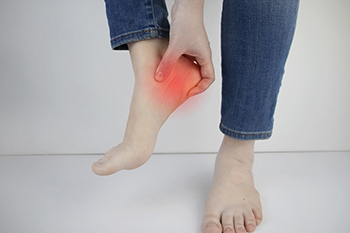 Plantar fasciitis is a painful heel condition that affects the plantar fascia (which is the fibrous band of tissue connecting the bottom of the foot to the heel bone and metatarsals at the ball of the foot). The plantar fascia helps maintain the arch of the foot, foot stability, and movement. Repeated stretching and contracting can result in micro-tears and/or inflammation of the plantar fascia. If the plantar fascia ruptures, the arch of the foot collapses and the foot flattens. People who suffer from plantar fasciitis often feel heel pain when getting out of bed or after prolonged sitting because the plantar fascia goes from a relaxed shortened state to a weighted, forced stretch. Those at greater risk for plantar fasciitis are those with flat feet, excessive foot pronation or feet that roll inward, high arches, weak plantar flexor muscles, those who run, and those who stand or walk for prolonged periods of time without sufficient rest and renewal. Because other types of heel pain may be misdiagnosed as plantar fasciitis, and untreated heel pain can worsen and interfere with daily functioning, if pain persists, a visit to a podiatrist is the best course of action for proper diagnosis and treatment.
Plantar fasciitis is a painful heel condition that affects the plantar fascia (which is the fibrous band of tissue connecting the bottom of the foot to the heel bone and metatarsals at the ball of the foot). The plantar fascia helps maintain the arch of the foot, foot stability, and movement. Repeated stretching and contracting can result in micro-tears and/or inflammation of the plantar fascia. If the plantar fascia ruptures, the arch of the foot collapses and the foot flattens. People who suffer from plantar fasciitis often feel heel pain when getting out of bed or after prolonged sitting because the plantar fascia goes from a relaxed shortened state to a weighted, forced stretch. Those at greater risk for plantar fasciitis are those with flat feet, excessive foot pronation or feet that roll inward, high arches, weak plantar flexor muscles, those who run, and those who stand or walk for prolonged periods of time without sufficient rest and renewal. Because other types of heel pain may be misdiagnosed as plantar fasciitis, and untreated heel pain can worsen and interfere with daily functioning, if pain persists, a visit to a podiatrist is the best course of action for proper diagnosis and treatment.
Plantar fasciitis can be very painful and inconvenient. If you are experiencing heel pain or symptoms of plantar fasciitis, contact one of our podiatrists from Westside Podiatry Center, LLP. Our doctors can provide the care you need to keep you pain-free and on your feet.
What Is Plantar Fasciitis?
Plantar fasciitis is the inflammation of the thick band of tissue that runs along the bottom of your foot, known as the plantar fascia, and causes mild to severe heel pain.
What Causes Plantar Fasciitis?
- Excessive running
- Non-supportive shoes
- Overpronation
- Repeated stretching and tearing of the plantar fascia
How Can It Be Treated?
- Conservative measures – anti-inflammatories, ice packs, stretching exercises, physical therapy, orthotic devices
- Shockwave therapy – sound waves are sent to the affected area to facilitate healing and are usually used for chronic cases of plantar fasciitis
- Surgery – usually only used as a last resort when all else fails. The plantar fascia can be surgically detached from the heel
While very treatable, plantar fasciitis is definitely not something that should be ignored. Especially in severe cases, speaking to your doctor right away is highly recommended to avoid complications and severe heel pain. Your podiatrist can work with you to provide the appropriate treatment options tailored to your condition.
If you have any questions please feel free to contact one of our offices located in Liverpool, Camillus, Skaneateles, Oswego, and Cicero, NY . We offer the newest diagnostic and treatment technologies for all your foot and ankle needs.
Plantar Fasciitis
Plantar fasciitis is one of the most common causes of heel pain. The plantar fascia is the thick band of tissue that connects the heel bone to the toes. When this band of connective tissue becomes inflamed, plantar fasciitis occurs. Fortunately, this condition is treatable.
There are several factors that may put you at a greater risk for developing plantar fasciitis. One of the biggest factors is age; plantar fasciitis is common in those between the ages of 40 to 60. People who have jobs that require them to be on their feet are also likely to develop plantar fasciitis. This includes factory workers, teachers, and others who spend a large portion of their day walking around on hard surfaces. Another risk factor is obesity because excess weight can result in extra stress being placed on the plantar fascia.
People with plantar fasciitis often experience a stabbing pain in the heel area. This pain is usually at its worst in the morning, but can also be triggered by periods of standing or sitting. Plantar fasciitis may make it hard to run and walk. It may also make the foot feel stiff and sensitive, which consequently makes walking barefoot difficult.
Treatment for plantar fasciitis depends on the severity of the specific case of the condition. Ice massage applications may be used to reduce pain and inflammation. Physical therapy is often used to treat plantar fasciitis, and this may include stretching exercises. Another treatment option is anti-inflammatory medication, such as ibuprofen.
If you suspect that you have plantar fasciitis, meet with your podiatrist immediately. If left untreated, symptoms may lead to tearing and overstretching of the plantar fascia. The solution is early detection and treatment. Be sure to speak with your podiatrist if you are experiencing heel pain.
What Causes Metatarsal Fractures?
The metatarsals, which run from the base of the toes along the bottom of your foot, are the most commonly injured bones in the foot. The 1st, 2nd, and 5th metatarsals are frequently fractured during sports activities. Some breaks can be caused by sudden impact, like dropping something heavy on the foot or hitting a hard object. Other common causes are twisting the ankle and landing improperly from a jump. These injuries are termed acute and can be extremely painful. Further, if the bone breaks through the skin, the injury is even more serious because it may also affect the soft tissues of the foot and be more prone to infection. Other metatarsal breaks take a longer time, usually a result of repetitive action, such as running for long distances or jumping, which gradually cracks the bones. These are known as stress fractures: hairline cracks that damage only a portion of the bone. Conditions such as osteoporosis (thinning of the bones) and rheumatoid arthritis can also cause stress fractures. If you have injured your midfoot area, it’s a good idea to make an appointment with a podiatrist as soon as possible for a complete exam and diagnosis.
Foot Pain
Foot pain can be extremely painful and debilitating. If you have a foot pain, consult with one of our podiatrists from Westside Podiatry Center, LLP. Our doctors will assess your condition and provide you with quality foot and ankle treatment.
Causes
Foot pain is a very broad condition that could be caused by one or more ailments. The most common include:
- Bunions
- Hammertoes
- Plantar Fasciitis
- Bone Spurs
- Corns
- Tarsal Tunnel Syndrome
- Ingrown Toenails
- Arthritis (such as Gout, Rheumatoid, and Osteoarthritis)
- Flat Feet
- Injury (from stress fractures, broken toe, foot, ankle, Achilles tendon ruptures, and sprains)
- And more
Diagnosis
To figure out the cause of foot pain, podiatrists utilize several different methods. This can range from simple visual inspections and sensation tests to X-rays and MRI scans. Prior medical history, family medical history, and any recent physical traumatic events will all be taken into consideration for a proper diagnosis.
Treatment
Treatment depends upon the cause of the foot pain. Whether it is resting, staying off the foot, or having surgery; podiatrists have a number of treatment options available for foot pain.
If you have any questions, please feel free to contact one of our offices located in Liverpool, Camillus, Skaneateles, Oswego, and Cicero, NY . We offer the newest diagnostic and treatment technologies for all your foot care needs.


